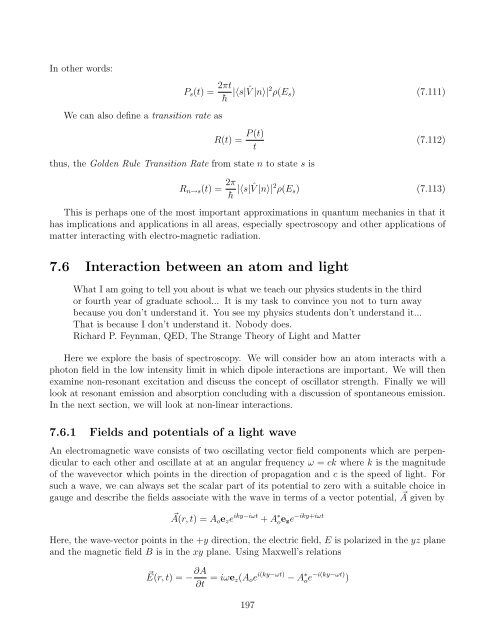Quantum Mechanics - Prof. Eric R. Bittner - University of Houston
Quantum Mechanics - Prof. Eric R. Bittner - University of Houston
Quantum Mechanics - Prof. Eric R. Bittner - University of Houston
Create successful ePaper yourself
Turn your PDF publications into a flip-book with our unique Google optimized e-Paper software.
In other words:<br />
We can also define a transition rate as<br />
Ps(t) = 2πt<br />
¯h |〈s| ˆ V |n〉| 2 ρ(Es) (7.111)<br />
R(t) =<br />
P (t)<br />
t<br />
thus, the Golden Rule Transition Rate from state n to state s is<br />
(7.112)<br />
Rn→s(t) = 2π<br />
¯h |〈s| ˆ V |n〉| 2 ρ(Es) (7.113)<br />
This is perhaps one <strong>of</strong> the most important approximations in quantum mechanics in that it<br />
has implications and applications in all areas, especially spectroscopy and other applications <strong>of</strong><br />
matter interacting with electro-magnetic radiation.<br />
7.6 Interaction between an atom and light<br />
What I am going to tell you about is what we teach our physics students in the third<br />
or fourth year <strong>of</strong> graduate school... It is my task to convince you not to turn away<br />
because you don’t understand it. You see my physics students don’t understand it...<br />
That is because I don’t understand it. Nobody does.<br />
Richard P. Feynman, QED, The Strange Theory <strong>of</strong> Light and Matter<br />
Here we explore the basis <strong>of</strong> spectroscopy. We will consider how an atom interacts with a<br />
photon field in the low intensity limit in which dipole interactions are important. We will then<br />
examine non-resonant excitation and discuss the concept <strong>of</strong> oscillator strength. Finally we will<br />
look at resonant emission and absorption concluding with a discussion <strong>of</strong> spontaneous emission.<br />
In the next section, we will look at non-linear interactions.<br />
7.6.1 Fields and potentials <strong>of</strong> a light wave<br />
An electromagnetic wave consists <strong>of</strong> two oscillating vector field components which are perpendicular<br />
to each other and oscillate at at an angular frequency ω = ck where k is the magnitude<br />
<strong>of</strong> the wavevector which points in the direction <strong>of</strong> propagation and c is the speed <strong>of</strong> light. For<br />
such a wave, we can always set the scalar part <strong>of</strong> its potential to zero with a suitable choice in<br />
gauge and describe the fields associate with the wave in terms <strong>of</strong> a vector potential, � A given by<br />
�A(r, t) = Aoeze iky−iωt + A ∗ oeze −iky+iωt<br />
Here, the wave-vector points in the +y direction, the electric field, E is polarized in the yz plane<br />
and the magnetic field B is in the xy plane. Using Maxwell’s relations<br />
�E(r, t) = − ∂A<br />
∂t = iωez(Aoe i(ky−ωt) − A ∗ oe −i(ky−ωt) )<br />
197


